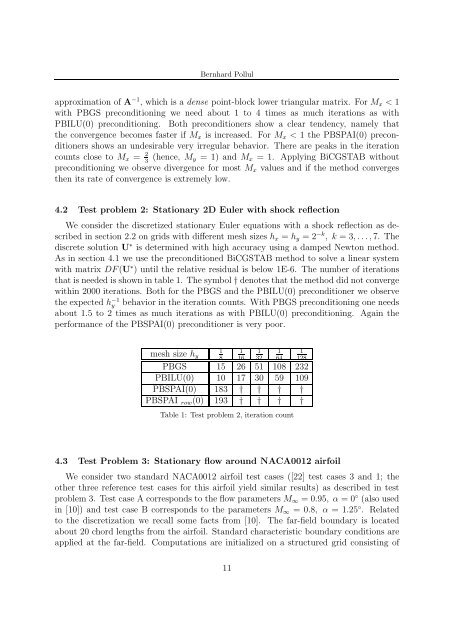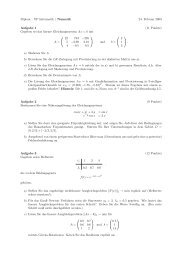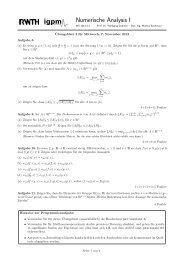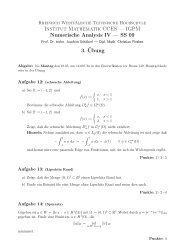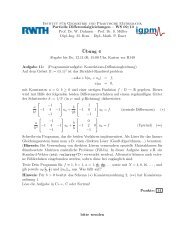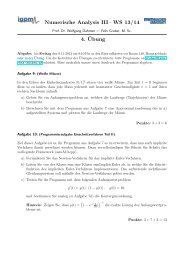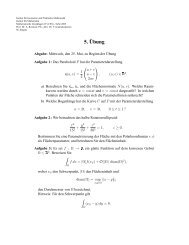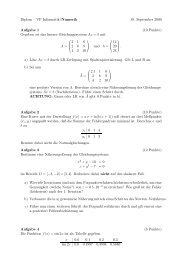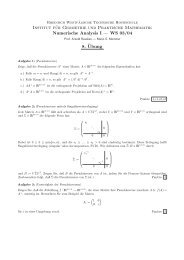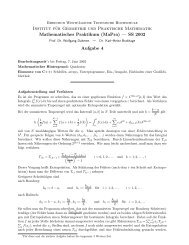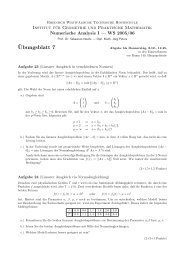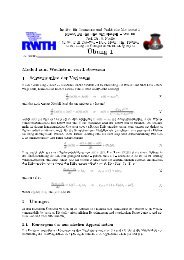preconditioners for linearized discrete compressible euler equations
preconditioners for linearized discrete compressible euler equations
preconditioners for linearized discrete compressible euler equations
Create successful ePaper yourself
Turn your PDF publications into a flip-book with our unique Google optimized e-Paper software.
Bernhard Pollul<br />
approximation of A −1 , which is a dense point-block lower triangular matrix. For M x < 1<br />
with PBGS preconditioning we need about 1 to 4 times as much iterations as with<br />
PBILU(0) preconditioning. Both <strong>preconditioners</strong> show a clear tendency, namely that<br />
the convergence becomes faster if M x is increased. For M x < 1 the PBSPAI(0) <strong>preconditioners</strong><br />
shows an undesirable very irregular behavior. There are peaks in the iteration<br />
counts close to M x = 2 3 (hence, M y = 1) and M x = 1. Applying BiCGSTAB without<br />
preconditioning we observe divergence <strong>for</strong> most M x values and if the method converges<br />
then its rate of convergence is extremely low.<br />
4.2 Test problem 2: Stationary 2D Euler with shock reflection<br />
We consider the discretized stationary Euler <strong>equations</strong> with a shock reflection as described<br />
in section 2.2 on grids with different mesh sizes h x = h y = 2 −k , k = 3, . . ., 7. The<br />
<strong>discrete</strong> solution U ∗ is determined with high accuracy using a damped Newton method.<br />
As in section 4.1 we use the preconditioned BiCGSTAB method to solve a linear system<br />
with matrix DF(U ∗ ) until the relative residual is below 1E-6. The number of iterations<br />
that is needed is shown in table 1. The symbol † denotes that the method did not converge<br />
within 2000 iterations. Both <strong>for</strong> the PBGS and the PBILU(0) preconditioner we observe<br />
the expected h −1<br />
y behavior in the iteration counts. With PBGS preconditioning one needs<br />
about 1.5 to 2 times as much iterations as with PBILU(0) preconditioning. Again the<br />
per<strong>for</strong>mance of the PBSPAI(0) preconditioner is very poor.<br />
mesh size h y<br />
1<br />
8<br />
1<br />
16<br />
1<br />
32<br />
1<br />
64<br />
1<br />
128<br />
PBGS 15 26 51 108 232<br />
PBILU(0) 10 17 30 59 109<br />
PBSPAI(0) 183 † † † †<br />
PBSPAI row (0) 193 † † † †<br />
Table 1: Test problem 2, iteration count<br />
4.3 Test Problem 3: Stationary flow around NACA0012 airfoil<br />
We consider two standard NACA0012 airfoil test cases ([22] test cases 3 and 1; the<br />
other three reference test cases <strong>for</strong> this airfoil yield similar results) as described in test<br />
problem 3. Test case A corresponds to the flow parameters M ∞ = 0.95, α = 0 ◦ (also used<br />
in [10]) and test case B corresponds to the parameters M ∞ = 0.8, α = 1.25 ◦ . Related<br />
to the discretization we recall some facts from [10]. The far-field boundary is located<br />
about 20 chord lengths from the airfoil. Standard characteristic boundary conditions are<br />
applied at the far-field. Computations are initialized on a structured grid consisting of<br />
11


